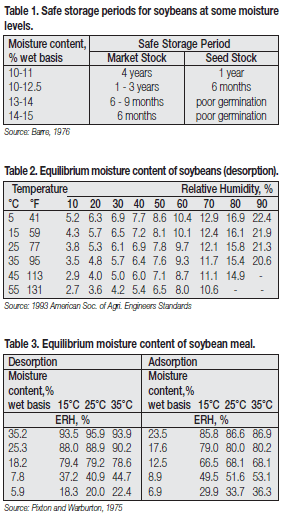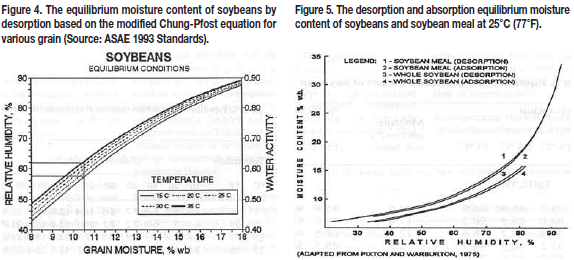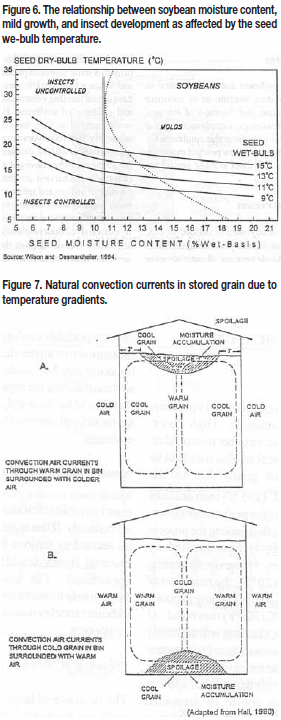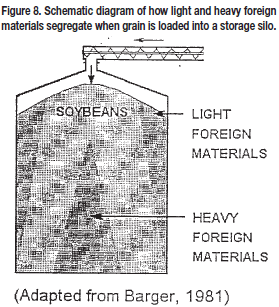Handling and Storage Of Soybeans and Soybean Meal: Part 2 - Factors Affecting Safe Product Storage
Factors Affecting Safe Product Storage
The three major factors affecting the storability of soybean and soybean meal are moisture content, temperature, and duration of storage. The general condition of the product and amount of foreign materials also affect their storability.

Moisture Content
Moisture is perhaps the most important single factor affecting storage of soybeans and soybean
meal. Soybeans contain moisture ranging from 12% to 15% (wet basis) at harvest time. Soybeans
with moisture above 13% should be dried to reduce the risk of deterioration due to seed respiration,
mold attack, spontaneous heating and reduced germination. It is widely recognized that there are
two forms of moisture in cereal grains and oilseeds:
b. bound moisture remains "locked" in the molecular structure of the grain and cannot be removed by drying
In general, soybeans can be kept for a given period of time with no appreciable degree of deterioration if the moisture content is relatively low. The safe moisture content of soybeans is presented in Table 1.
Soybeans and soybean meal are hygroscopic materials and will either lose (desorb) or gain (adsorb) moisture from the surrounding air. The moisture level reached by a product at a given constant temperature and equilibrium relative humidity (ERH) is its equilibrium moisture content (EMC). The EMC and ERH of soybean meal are illustrated in Tables 2 and 3. The equilibrium moisture content of soybeans by desorption at various temperatures and relative humidities are presented in Figure 4.
The EMC values for soybeans are based from the widely accepted modified Chung-Pfost equation used for determining EMC and ERH for various grains. The desorption and adsorption EMC curves for soybeans and soybean meal at 25 c (77 °F) are shown in Figure 5.
The EMC of soybeans and soybean meal by desorption are higher than that by adsorption under the same set of conditions. This phenomenon is known as hysteresis. It occurs in most agricultural products such as cereal grains, oilseeds, leathers, meats and even vegetables. However, the hysteresis effect in grain diminishes after repeated adsorption and desorption cycles. In soybeans and soybean meal, hysteresis is less pronounced compared with that of cereal grains.

Furthermore, the ERH of the meal is lower than that of whole soybeans at all moisture levels because of its lower oil content. This means that under the same air relative humidity, soybean meal will have higher EMC than whole soybeans.
The rate of moisture adsorption or desorption is directly related to the manner by which a product is exposed to the atmosphere. For example soybeans kept in jute sacks tend to gain or lose moisture more readily than soybeans in bulk form. Hence, bag storage has as self-ventilating and cooling characteristic that makes it the preferred method over bulk system in many developing countries. However, bulk storage of soybeans allows the use of aeration or cooling techniques to maintain its desirable quality in a controlled manner. Aerating soybeans in bags is also possible but is not practical because of the uneven airflow patterns resulting in non-uniform grain temperature.

Temperature
Temperature is another very important factor
influencing soybean storage. Growth of fungi and
chemical changes such as oxidation increased
with temperature in both meal and whole beans.
Insects develop and reproduce best between 27
and 35 c (80 to 95 °F). Below 16 c (60 °F) insects
become inactive and die of starvation. Exposure
to temperature greater than 600C (140 °F) kills
most insect species in 10 minutes.
Soybeans with a moisture contents of 14 - 14.3% and maintained at 5- 8 c (41- 46 °F) can be stored for over two years without mold damage while soybeans kept at 300C (860F) can be invaded by molds in a few weeks and severely damaged in six months. Recent studies indicate that soybeans can be stored at 10.5% moisture at any temperature without the danger of mold attack (Figure 6). However, at this moisture content, insect infestation may develop unless its temperature is maintained below 20 c (68 °F). This is equivalent to a seed wet-bulb temperature of 15 c (59 °F) or corresponding relative humidity of 60%.
Temperature also influences moisture migration. The driving force in moisture migration in a grain mass is temperature gradient. This condition causes very small air movements and water vapor translocation in the grain mass. It has been estimated that a grain mass temperature gradient of about 16.7 c (30 °F) can induce an inter-seed airflow of 0.06 m / min (0.2 ft / min). Thus, grains stored at moisture contents considered safe, may spoil because of moisture migration associated with inter-seed air currents. The general movement of air in a grain bulk under two climatic conditions characterized by warmer outside air and colder outside air are shown graphically in Figure 7. The air movements in the grain bin is influenced by the outside air temperature that creates temperature gradients in the entire grain mass. This phenomenon affects all types of storage silos whether it is made of concrete or metal. They vary only on the magnitude of air movement.
Because of the insulating property of grains, the effect of diurnal temperature changes on the stored grain is minimal but is cumulative. It takes a long time of relatively constant high temperature gradients to initiate the air movements shown in the diagrams to occur. However, experience indicates that under hot and humid tropical conditions, grains stored in metal bins exhibit "sweating" next to the wall. This can be attributed to extreme high temperatures reached at the inner surface of the metal silo on a hot day. At night, rapid cooling of the metal results in moisture condensation as the dew point is reached. Caking and charring in metal silos can be attributed to this phenomenon.
Duration Of Storage
Deterioration of soybeans and soybean meal in storage is a combined function of its moisture content,
temperature, and duration of storage. Therefore, for safe storage, a combination of the three factors
providing unfavorable conditions for mold development, such as low product moisture, low temperature,
and short storage period are desirable.

Foreign Material Present
Foreign material in soybeans is defined in U.S.
Standards as all materials that pass through a
3.2 mm (8 /64-inch) round-hole sieve and all
materials other than soybeans remaining on the
sieve. Fine foreign materials tend to segregate
during bin loading and occupy void spaces in the
central region of the grain mass. Meanwhile, the
large and lighter materials will accumulate close
to the walls of the silo. The process of material
segregation inside a storage silo is illustrated in
Figure 8.
During aeration, the air will flow around spots with higher concentration of fine foreign materials and through pockets of high concentration of large foreign materials. This condition will create a nonuniform flow of air during aeration, thus, making it an ineffective operation.
Consequently, the non-aerated pockets in the grain mass are potential sites for hot spots that will provide ideal environment for insects to grow and multiply. Hence, cleaning soybeans prior to storage will minimize the risk of spoilage and economic loss. This should be part of an integrated approach to any quality maintenance program of grain processing companies.
Product Condition And History
Sound soybean kernels will store better than kernels damaged by freezing, cracking, splitting, and
storage fungi. Split kernels are more susceptible to attack by stored product insects and fungi than
whole kernels. It is generally recognized that a sound seed coat provides some degree of protection
against insect and fungal attack. For this reason, it is preferred to have a grain handling system that
minimizes cracking and splitting of soybeans. Belt conveyors are recommended as they handle grain
gently and efficiently. Belt conveyors can also move grains for great distances without damage. It is
very common for soybeans to be conveyed as many as 15 to 19 times between harvest processing
or export. The amount of broken and split kernels increases with every handling and conveying
operation. In terms of insect attack, soybean meal is far more susceptible to moth and red flour beetle
infestation than whole soybeans. Weevils deposit their eggs on whole soybeans where the larva will
hatch and feed on the bean.
Handling and Storage Of Soybeans and Soybean Meal: Part 3 - Deterioration Indicators
Handling and Storage Of Soybeans and Soybean Meal: Part 4 - Chemical Changes In Storage
Handling and Storage Of Soybeans and Soybean Meal: Part 5 - Maintenance Of Quality
Handling and Storage Of Soybeans and Soybean Meal: Part 6 - Summary




